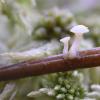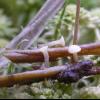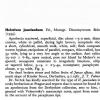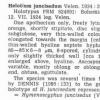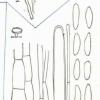
09-01-2026 17:41
Arnold BüschlenHallo, F. dilatata wird von vielen Bryoparasiten

10-01-2026 20:00
Tom SchrierHi all,We found picnidia on Protoparmeliopsis mur

07-01-2026 22:22
 Danny Newman
Danny Newman
Tatraea sp. on indet. hardwood The Swag, Great Sm

10-01-2026 01:18
 Danny Newman
Danny Newman
cf. Neovaginatispora fuckelii on indet. shrub Pre

07-01-2026 10:24
 Danny Newman
Danny Newman
Pezicula sp. on indet. hardwood Appalachian Highl

09-01-2026 10:08
 Blasco Rafael
Blasco Rafael
Hola, en el mismo habitat que la anteriorRetamaDia

08-01-2026 21:22
 Blasco Rafael
Blasco Rafael
Hola, He recogido esta muestra de Orbilia sobre Re

07-01-2026 17:29
 Marc Detollenaere
Marc Detollenaere
Dear Forum,On a barkless Populus I found some smal

10-11-2021 17:33
 Riet van Oosten
Riet van Oosten
Add-on topic http://www.ascofrance.com/forum/7059

07-01-2026 10:05
 Danny Newman
Danny Newman
cf. Chaetospermum on XylariaCosby Campground, Grea
Cudoniella junciseda?
DirkW,
24-05-2020 00:52
 Salut a tous!
Salut a tous!Anybody out there, who made experiences with/finds of Cudoniella junciseda?
A few days ago we found these little stalked Apothezia on Juncus in a very water-soaked meadow.
Small: 0,3-0,4 cm high, Hymenium 0,2 cm. Base not blackening. Reddening with age.
Spores 11-13 x 4-5, eguttulate, ciboroid, sometimes ovoid, uniseriat. Asci 70-90 x 7, IKI + (very weak, but visible), Croziers. Paraphyses with refractive Guttules. Textura intricata. So, basically this looks like a bonsai-version of cudoniella clavus ;-)
Its quite strange that the Taxon Cudoniella junciseda is shortly mentioned in Dennis and Ellis & Ellis and after this, there is simply nothing. Nothing we know at least. Who knows more?
All best
Dirk
Hans-Otto Baral,
24-05-2020 06:51

Re : Cudoniella junciseda?
Hi Dirk
I think what you have is C. clavus. But the ectal excipulum should be of t. prismatica.
C. junciseda was described by Dennis 1962: 320 from a find by JT Palmer, with narrowly clavate spores of 9-14 x 2.5-4. I do not have a scale to his drawing but it seems to mke that 4 µm is too broad.
But Velenovsky's short protologue might indeed refer to C. clavus.
Zotto
Viktorie Halasu,
24-05-2020 08:02
Hans-Otto Baral,
24-05-2020 08:10
DirkW,
24-05-2020 19:24

Re : Cudoniella junciseda?
dear viktorie and zotto, thank you very much for the fast response and interesting material! very confusing the descriptions and seemingly not reffering to one single taxon! in the Svrcek-revision a textura globulosa-angularis is mentioned! the description and drawning of dennis/palmer says something different.
perhaps zotto is right, and velenovsky was just mislead (as we) by uncharakteristic small apothezia! the variety in c. clavus is really confusing ...
best
dirk
perhaps zotto is right, and velenovsky was just mislead (as we) by uncharakteristic small apothezia! the variety in c. clavus is really confusing ...
best
dirk
DirkW,
25-05-2020 14:10

Re : Cudoniella junciseda?
another point, which is mysterious in case of c. clavus is, that generally a J- is stated in publications! but thats not the case ... its weak, but its there.
Viktorie Halasu,
25-05-2020 15:47

Re : Cudoniella junciseda?
MLZ vs. IKI ?
Hans-Otto Baral,
25-05-2020 20:49

Re : Cudoniella junciseda?
Yes, MLZ could be a reason for a negative report, but also variation may be the reason, which I think I have observed in C. clavus. In another case, Phaeohelotium epiphyllum, I have IKI- and IKI+ collections combined with DNA data which fully concur in the ITS.
So an absent reaction is not necessarily a sign for a separate species.
